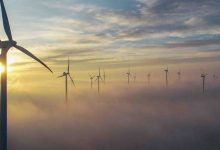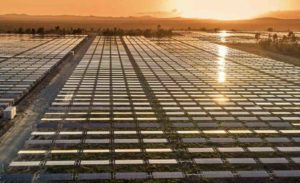For the first time wind energy became Ireland’s leading source of electricity for a full quarter, beating out natural gas for the first three months of 2020, when it accounted for 43.8% of demand compared to natural gas’s 41.8%.
According to figures published this week by the Sustainable Energy Authority of Ireland (SEAI), the country’s wind energy sector generated 3,390GWh of electricity over the first three months of 2020, equivalent to the power demand of 737,000 Irish homes.
Importantly, wind energy’s new quarterly record was bolstered by a 16.8% increase over the same quarter a year earlier.
Natural gas, on the other hand, generated 3,234GWh, accounting for 41.8% of Ireland’s first-quarter electricity demand, increasing only 2% over the same period a year earlier.
“Today’s figures show that it is only a matter of time before wind energy is Ireland’s number one source of electricity,” said Dr David Connolly, CEO of the Irish Wind Energy Association.
“Last year was a record-breaking year for the industry as we provided a third of the country’s electricity demand. The first three months of 2020 show that we are well on track to beat that record.
“More wind power means less carbon emissions. It means less fossil fuel imports. It means more jobs and more investment in Ireland.”
The record-breaking announcement came just a week after the SEAI published its Renewable Energy in Ireland 2020 report which concluded that Ireland is not on track to meet its renewable energy targets.
Ranked 26 out of 28 European Union countries for progress towards their 2020 renewable targets, Irish renewable energy sources supplied only 11% of overall energy use in 2018.
Based on 2018 data – which predates the country’s Climate Action Plan – the findings nevertheless highlight the importance and urgency of the work which was set out in that Plan.
“This report demonstrates the challenges we face in transitioning away from fossil fuels,” said Jim Scheer, Head of Data and Insights at SEAI. “Most of the energy we use to generate electricity, to heat our homes and business and for transport comes from burning fossil fuels like gas, coal, peat and oil.
We need to eliminate energy waste and transition to using more renewable sources of energy like wind, solar, heat pumps and bioenergy as quickly as we can.
“The Government’s Climate Action Plan sets out an ambitious course of action that could help us to kick our fossil fuel habit and reduce greenhouse gas emissions. As citizens, we can play our part by considering how we can reduce fossil fuel use in our homes and how we travel.”
This week’s wind energy record announcement serves as a further call for Ireland to double-down on the Climate Action Plan’s target of providing 70% of the country’s electricity from renewable energy sources by 2030.
“It is essential, if we are to build on this success, that the next Government prioritises reforming our planning system so we can develop wind energy off our coasts and ensures that the new Wind Energy Guidelines enable us to build the next generation of onshore wind farms,” said Dr Connolly.
“It is the next Government that must ensure we have the right policies and the right strategies to enable industry to reach the target set out in the Climate Action Plan to provide 70 per cent of Ireland’s electricity from renewable energy by 2030.
“It can take eight to 12 years to develop a wind farm in Ireland. This means that any Government serious about our 2030 targets has – at most – only a couple of years to make the right policy choices to grow Ireland’s renewable energy industry and turn this country into a leader in the fight against climate change.”








